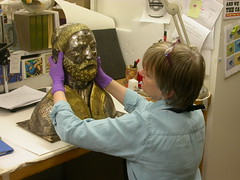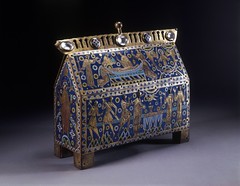By Stuart Frost
Earlier this week relics of Saint Thérèse of Lisieux arrived at Westminster Cathedral in London as the culmination of a month long tour of Britain. The reaction from the public and the media has been remarkable. The relics of this French nun, who died in 1897 at the age of twenty-four, have drawn massive crowds as they have travelled around the country. Over two thousand pilgrims an hour are expected to visit Westminster Cathedral to venerate the relics during their comparatively short stay in the capital.
The scenes of devotion that have accompanied the tour are a reminder that British society isn’t quite as secular as is often assumed. In a decade dominated by the cult of celebrity, the response to the tour of St Thérèse’s relics demonstrates that the cult of saints remains central to the lives of many Christians in the United Kingdom. The significant number of new saints created by the Papacy in the twentieth century also serves to illustrate the continuing centrality of saints in Roman Catholicism.
At the age of fifteen Thérèse became a Carmelite nun at Lisieux where she remained until her death from tuberculosis just eight years later. Her life became more widely known through her short autobiography. L’Histoire d’une Âme (The Story of a Soul). She was canonised, officially recognised as saint by the Roman Catholic Church, in 1925.
The veneration of saints was of course, extremely popular throughout medieval and Renaissance Europe. The V&A’s collections include a number of extremely beautiful and significant reliquaries, elaborate containers made to hold relics associated with saints. Almost all of these reliquaries are now empty, the relics they once held lost or removed long before the objects came to the Museum. At the V&A these reliquaries are now appreciated primarily for their aesthetic qualities but the response to St Thérèse’s relics is a reminder of the spiritual signficance they once had. I’ve written about a number of reliquaries over the last three years, most recently about one associated with St Sebastian. The photograph that heads this blog entry shows conservation work undertaken in January 2007 on a reliquary of St Antigius.
 The most well known reliquary in the V&A’s collections is arguably one that is associated with St Thomas Becket and which was probably made in 1180, just ten years or so after the murder of the Archbishop in Canterbury Cathedral. The shrine of Thomas Becket become one of the most popular destinations for pilgrims in Britain and Europe. Relics associated with Becket were in great demand.
The most well known reliquary in the V&A’s collections is arguably one that is associated with St Thomas Becket and which was probably made in 1180, just ten years or so after the murder of the Archbishop in Canterbury Cathedral. The shrine of Thomas Becket become one of the most popular destinations for pilgrims in Britain and Europe. Relics associated with Becket were in great demand.
The relics of saints (sometimes parts of their bodies) were often divided between churches and saints’ relics were sometimes removed (or stolen) from shrines. Some of St Thérèse relics have remained in France, and indeed have also been touring the country there. However In medieval and Renaissance Europe pilgrims tended to travel to visit the shrines of saints rather then the relics being brought to churches near them in the manner of the current tour of St Thérèse’s relics.
Unfortunately I don’t have any pictures of the reliquary which contains St Thérèse’s relics. However there are plenty or articles and images on the websites of most of the major newspapers, testament to the manner in which the story of St Thérèse has captured the media’s attention.